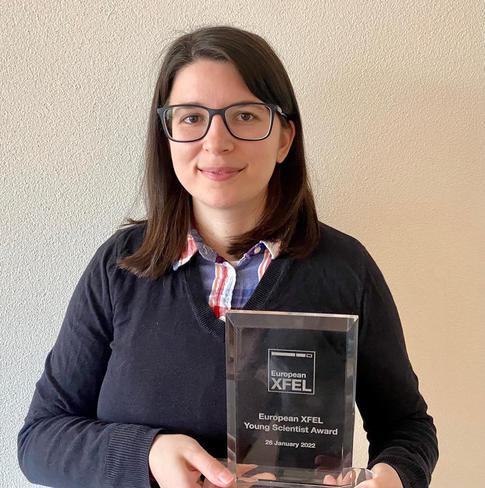XFEL: European XFEL Young Scientist Award goes to Camila Bacellar
European XFEL Young Scientist Award goes to Camila Bacellar

Camila Bacellar, the European XFEL Young Scientist Award recipient 2022. Copyright: PSI
Camila Bacellar, beamline scientist at the SwissFEL, the Swiss X-ray free-electron laser at the Paul Scherrer Institute, was honoured with the European XFEL Young Scientist Award at the European XFEL User Meeting on 26 January for her work in the field of excited state dynamics in chemical and biological systems. At the European XFEL experiment station for femtosecond X-ray experiments (FXE), she studied heme proteins, which are among the most important building blocks of our bodies. "Camila Bacellar receives the European XFEL Young Scientist Award 2022 for her excellent research on heme proteins using femtosecond X-ray spectroscopy in the framework of the user programme at the FXE experiment station," explains Sakura Pascarelli, Scientific Director at European XFEL.
At the European XFEL Users' Meeting, Bacellar gave insights into her research, explained the importance of the European XFEL for her field and cast a glance into the future.
What has been the focus of your research?
My research has been focused on understanding and mapping out excited state dynamics in chemical and biological systems using X-ray techniques (spectroscopy and scattering). Experimentally, we use an ultrafast optical laser pulse to initiate the process we are interested in studying and follow its evolution by using X-ray pulses (from Free Electron laser facilities) to take snapshots of the system at different points in time, making a so-called molecular movie.
What is the importance of European XFEL in your area of research?
X-ray spectroscopy techniques are unique in that they provide element specificity, meaning you can interrogate a single element in a large molecule, and electronic and structural information, so you can follow with a lot of detail the evolution of the excited system in time and space. To do so, femtosecond X-ray pulses with high brilliance are necessary, and they are produced in X-ray Free Electron Laser facilities. In my research, I use hard X-rays which are available in only five facilities around the world, and European XFEL is one of them. Particularly, the high repetition rate of the X-rays at European XFEL makes it possible to study challenging samples with photon-hungry techniques, such as X-ray Emission Spectroscopy (XES).
Could you give some more details on what your talk at the Users’ meeting was about?
In my talk, I showed the study of the dynamics of two heme proteins, that were carried out in part, in two different beamtimes at European XFEL’s FXE beamline in a large collaborative effort with researchers from EPFL, PSI, European XFEL, and SACLA. Heme systems are amongst the most important proteins in our body and understanding the evolution of their excited state gives us further insight into how they perform their function. We focused on two proteins, nitrosyl myoglobin and ferric cytochrome c, and the results have been recently published (https://www.nature.com/articles/s41467-020-17923-w and https://www.pnas.org/content/117/36/21914 respectively).
What future directions do you see for your field?
There are many interesting developments happening right now in chemical dynamics at FELs. I'm particularly interested in the ever-growing applications of time-resolved X-ray emission spectroscopy, especially valence-to-core emission lines, which have very low cross-sections but are a possibility at high-brightness sources. These particular transitions are much more sensitive to valence electron dynamics than the more commonly used core-to-core transitions but are very challenging to implement in "real world" samples, in a time-resolved fashion.
